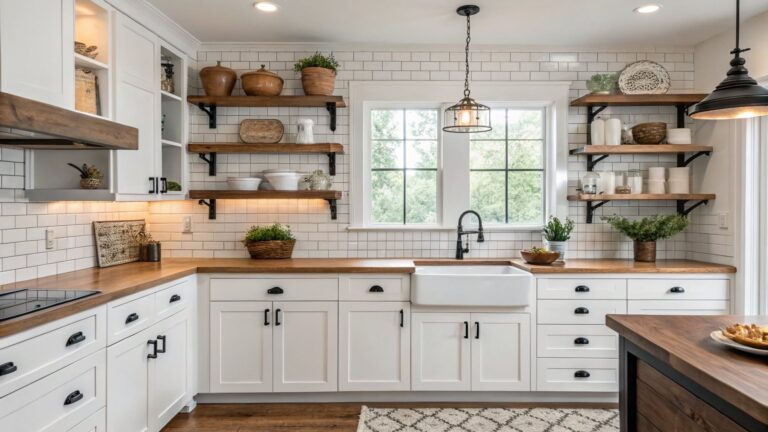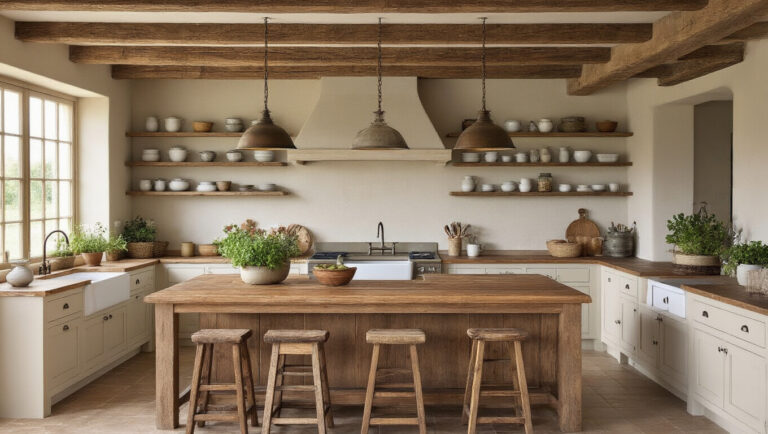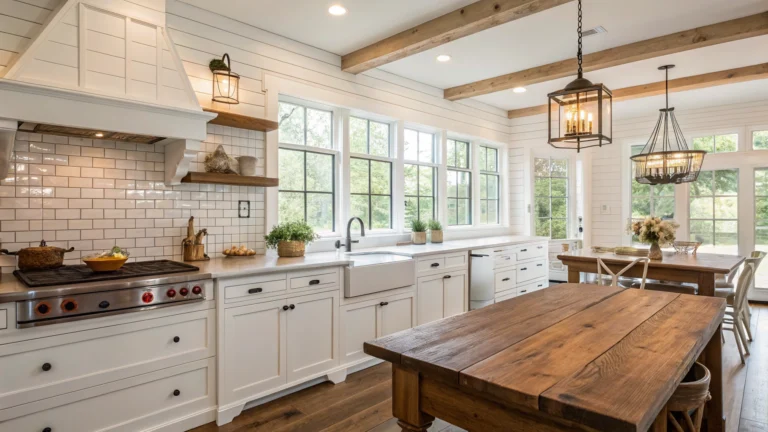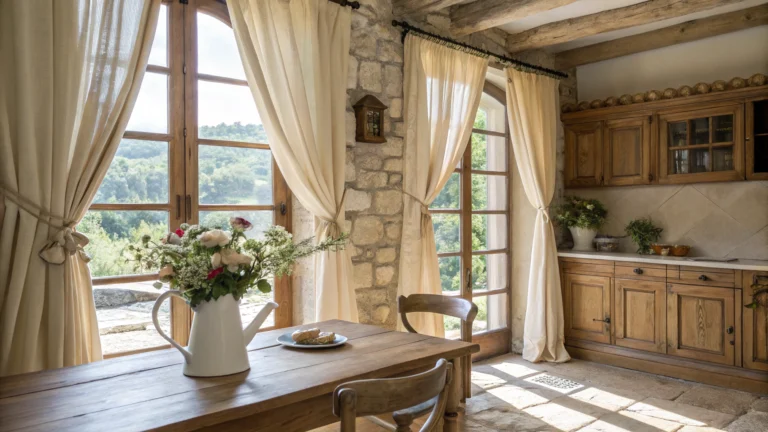European Farmhouse Kitchen Design for a Refined Look
The allure of European farmhouse kitchen design lies in its perfect blend of rustic charm and refined elegance. This style captures the cozy warmth of rural living while incorporating sophisticated elements that elevate its aesthetic appeal. In this article, we’ll explore how to achieve a European farmhouse kitchen look that is both welcoming and chic.
1. Embracing Natural Materials
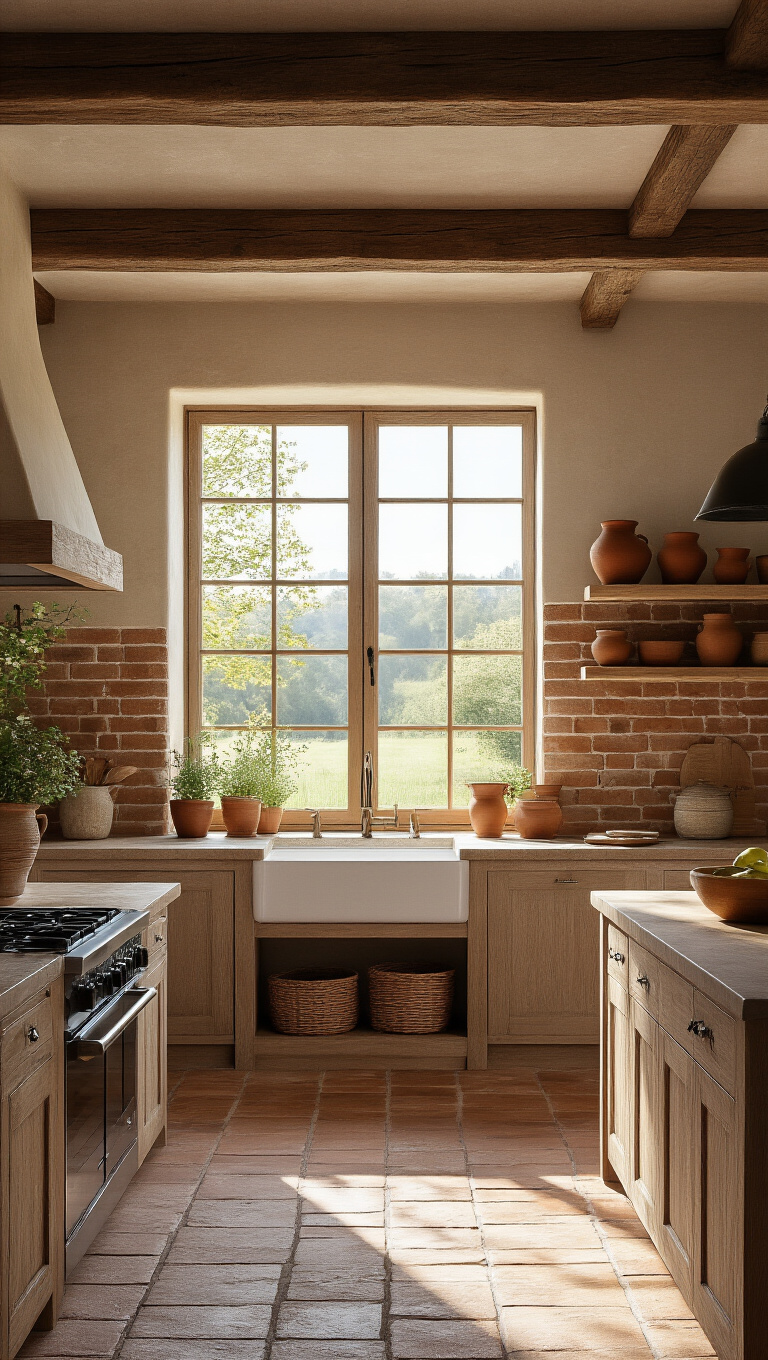
The heart of any European farmhouse kitchen is its use of natural materials that exude warmth and authenticity. Starting with wooden elements, think about wide rustic planks for your floors, perhaps made of reclaimed wood to give your kitchen that aged, lived-in feel. Wooden beams on the ceiling, whether exposed or subtly embedded, add a layer of rustic charm. Countertops made of natural stone like soapstone or marble can also enhance the kitchen’s organic feel while providing durability and elegance.
Accenting with other natural materials such as clay, brick, or earthenware can further enrich the texture and visual appeal of your European farmhouse kitchen. Brick backsplashes, for instance, can add a touch of vintage allure, while clay pottery displayed on open shelving brings a sense of rural simplicity. These elements, coupled with neutral tones and soft fabrics like linen or cotton, create a harmonious environment where modern meets traditional in a seamless blend.
2. Incorporating Vintage Accents

Adding vintage accents to your European farmhouse kitchen can instantly transport you to a bygone era, evoking a sense of nostalgia and warmth. Think about incorporating elements like antique wooden bowls, retro mixers, or enamel cookware that speak volumes about timeless charm. These pieces not only serve as functional kitchen tools but also as conversation starters that bring stories of the past into your daily culinary adventures.
Another way to infuse a European farmhouse kitchen with vintage appeal is by choosing lighting fixtures that harken back to simpler times. Look for wrought iron chandeliers or pendant lights with Edison bulbs, which can create a cozy, inviting ambiance reminiscent of a rustic French countryside home. These lighting choices, paired with classic kitchen tiles or aged copper cookware, complete the authentic vintage look that blends beauty with practicality.
3. Open Shelving for a Rustic Display

Open shelving is a hallmark of European farmhouse kitchen design that brings charm and functionality into any cooking space. These shelves provide easy access to everyday essentials while showcasing your beautiful ceramic dishes, rustic pottery, and artisanal cookware. By replacing traditional upper cabinets with open shelves, you create a more spacious and inviting atmosphere that encourages guests to relax and linger. The key is to strike a balance between practicality and aesthetics, ensuring that your display is both functional and visually appealing.
When incorporating open shelving into your European farmhouse kitchen, consider using reclaimed wood or wrought iron brackets to enhance the rustic charm. The variety in materials can add texture and warmth, helping to create a refined look that feels both timeless and authentic. Arrange items with purpose, combining different heights, colors, and textures to draw the eye and maintain an uncluttered appearance. The shelves also offer an opportunity to express personal style through seasonal accents like fresh herbs, vintage glassware, or market finds from your travels.
4. Integrating Classic European Color Palettes
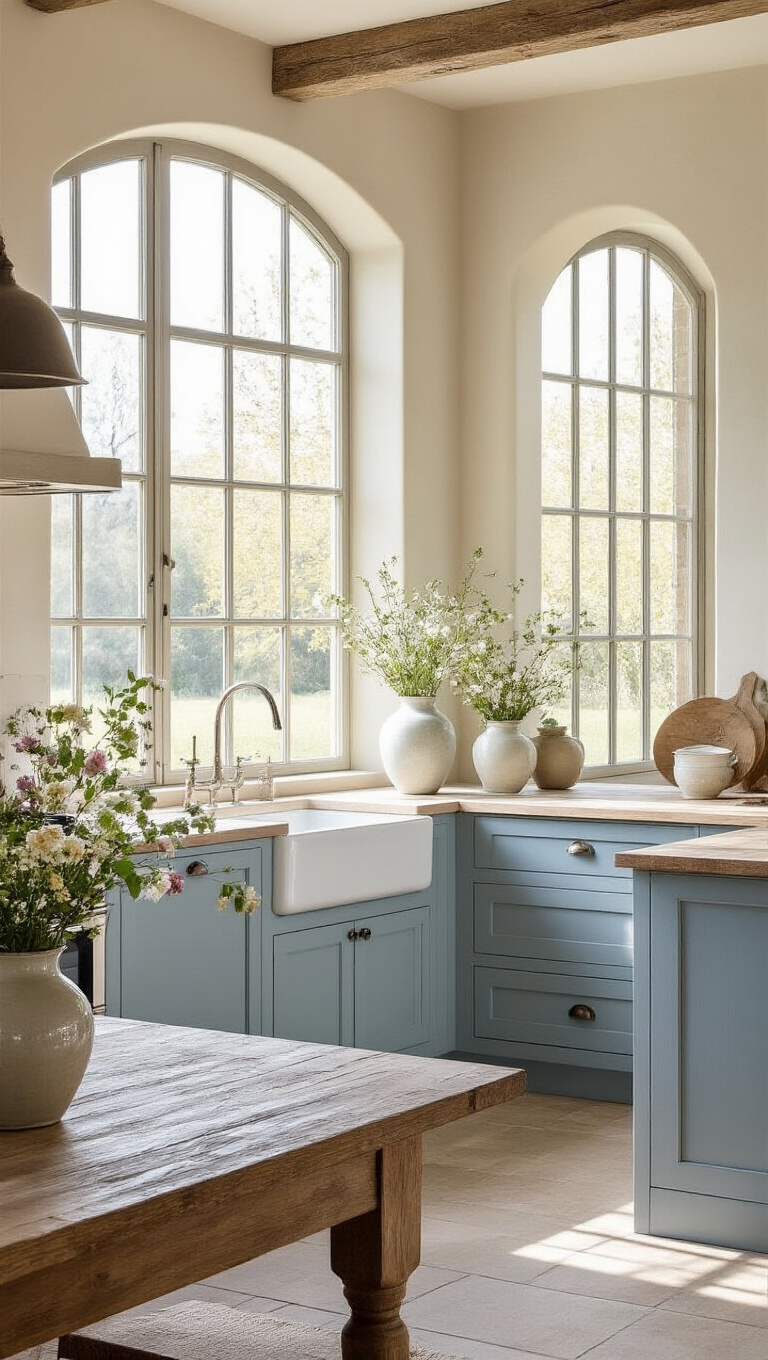
Transform your kitchen into a charming European farmhouse by embracing classic color palettes that exude warmth and elegance. Think muted earth tones and subdued pastels, which are essential for creating that timeless feel reminiscent of the European countryside. These colors not only brighten up your kitchen space but also imbue it with a sense of calmness and tranquility, making it a perfect backdrop for cozy family meals or gatherings with friends. Consider soft creams, gentle blues, and warm greys, which can be paired with rustic wooden elements to amplify the farmhouse vibe.
To truly capture the essence of a European farmhouse kitchen, blend these color palettes with natural light, which accentuates the soft hues and makes the space feel expansive and inviting. Layer your colors strategically by using lighter shades on walls and ceilings while opting for deeper tones on cabinetry and furniture. This approach not only adds depth but also highlights the architectural details of your kitchen. The secret to nailing this look is maintaining a harmonious balance between light and dark elements, allowing the natural charm of European aesthetics to shine through beautifully.
5. Choosing Timeless Appliances

One of the keys to achieving an authentic European farmhouse kitchen is to select appliances that blend seamlessly with the overall aesthetic. Classic pieces such as cast iron stoves or vintage-style refrigerators can add a touch of charm and anchor the space in tradition. These appliances aren’t just about looks—they also provide functionality that stands the test of time, marrying old-world charm with modern efficiency.
When opting for these timeless appliances, it’s important to consider their finish and color. Soft, muted tones or antique finishes complement the rustic vibe of a European farmhouse kitchen. Stainless steel, for example, can be polished but has an industrial edge that may not align with the warmth and coziness typical of this style. It’s these little details that make the entire space feel cohesive yet sophisticated, inviting, and completely immersive.
6. Inviting Warmth with Copper Accents

Copper accents are a quintessential element to elevate a European farmhouse kitchen, adding both warmth and sophistication. These gleaming metals tie in seamlessly with the rustic aesthetic while introducing an elegant yet homely feel. From copper pots and pans gracefully hanging over a central kitchen island to copper sinks and faucets that offer both function and style, every detail can contribute a touch of old-world charm. Not only do copper elements age beautifully, developing a unique patina over time, but they also serve as stunning focal points that can brighten up the kitchen space.
The beauty of copper lies in its versatility, which allows it to complement various design schemes and color palettes typical of a European farmhouse kitchen. Combining copper with neutral tones or deep, rich colors can draw attention to key features, making spaces feel both cozy and refined. These copper details can effortlessly balance modern appliances with traditional decor, creating a harmonious fusion that is very much in demand. Incorporating copper into the European farmhouse style also taps into an enduring design trend that celebrates craftsmanship and history.
7. Incorporating Handcrafted Tilework

Adding handcrafted tilework to your European farmhouse kitchen is a brilliant way to introduce a personal and artistic element to the space. These tiles, often adorned with intricate patterns reminiscent of European artistry, can serve as a stunning focal point when used for backsplashes or even flooring. The charm of handmade tiles lies in their unique imperfections and rich textures, which add depth and character to the kitchen environment. By selecting tiles crafted from natural materials like terracotta or ceramic, you further enhance the rustic, organic feel that is so central to European farmhouse design.
When it comes to colors and designs, the options are vast and can be tailored to suit your personal style. Consider using tiles with soft pastel hues for a touch of Provencal charm or opt for bold, Moorish-inspired patterns to create a dramatic visual impact. The key is to ensure that the tilework complements the other elements in your kitchen, tying together the vintage accents and natural materials to create a cohesive, inviting space. This thoughtful incorporation of handcrafted tiles not only elevates the aesthetic appeal but also celebrates the rich tradition of European craftsmanship that has been honed over centuries.
8. Adding Character with Reclaimed Wood Features
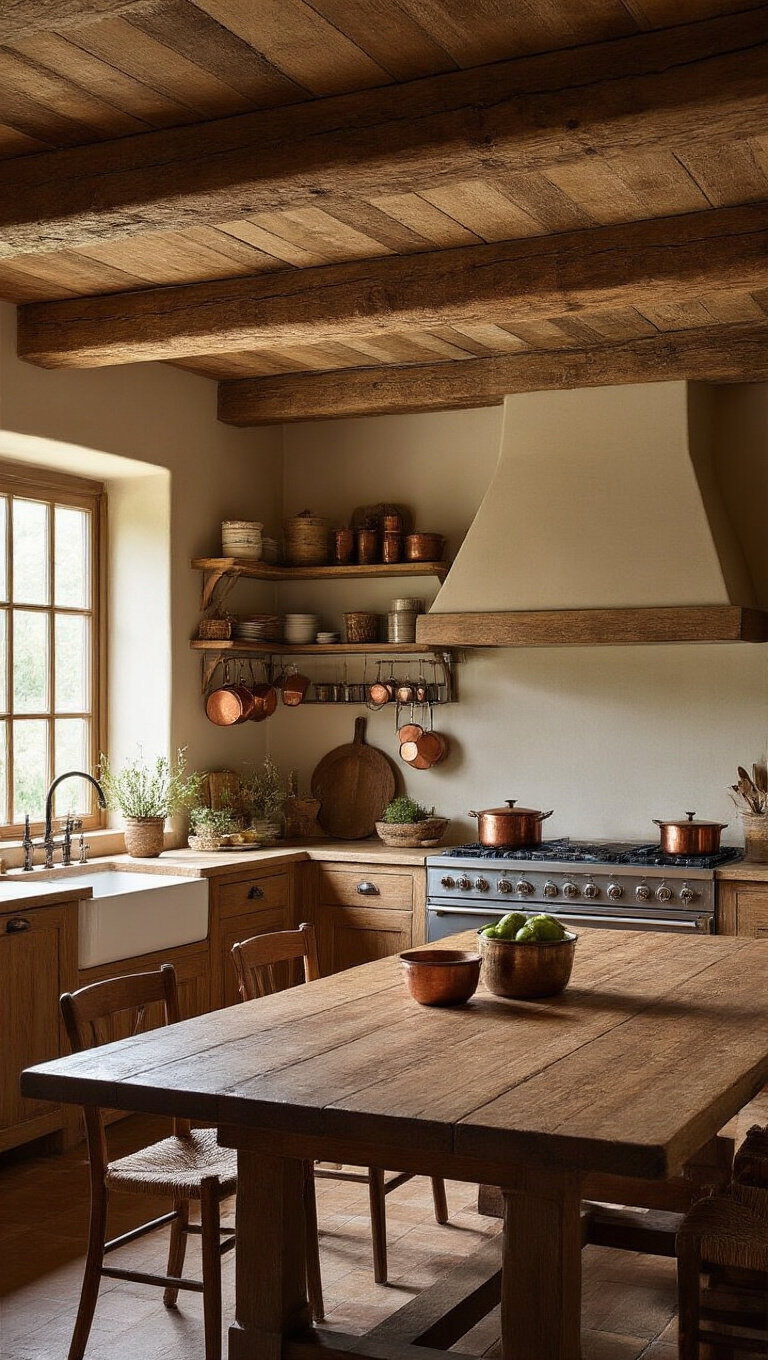
One way to truly encapsulate the essence of a European farmhouse kitchen is by incorporating reclaimed wood into your design. Reclaimed wood offers a beautiful character and history, bringing an authentic rustic charm that speaks to the time-honored traditions of European farming communities. Whether it’s a weathered wooden beam overhead, a sturdy reclaimed oak dining table, or vintage wooden cabinets, these elements add texture and warmth that’s both sustainable and story-rich. The beauty of reclaimed wood lies in its imperfections—the knots, the grain patterns, and the signs of its past life which create a unique and inviting atmosphere.
When you use reclaimed wood in your kitchen, you’re also making a conscious choice for sustainability. By opting for materials that have been repurposed, you’re reducing waste and minimizing the demand for new resources. This eco-friendly approach not only complements the rural, natural aesthetic of the European farmhouse kitchen but also supports a more sustainable lifestyle. Carefully balanced with other materials and colors, reclaimed wood can serve as a stunning focal point, harmonizing with both modern conveniences and vintage accessories to create a space that is both refined and lived-in.
9. Integrating Authentic European Artisanal Fixtures
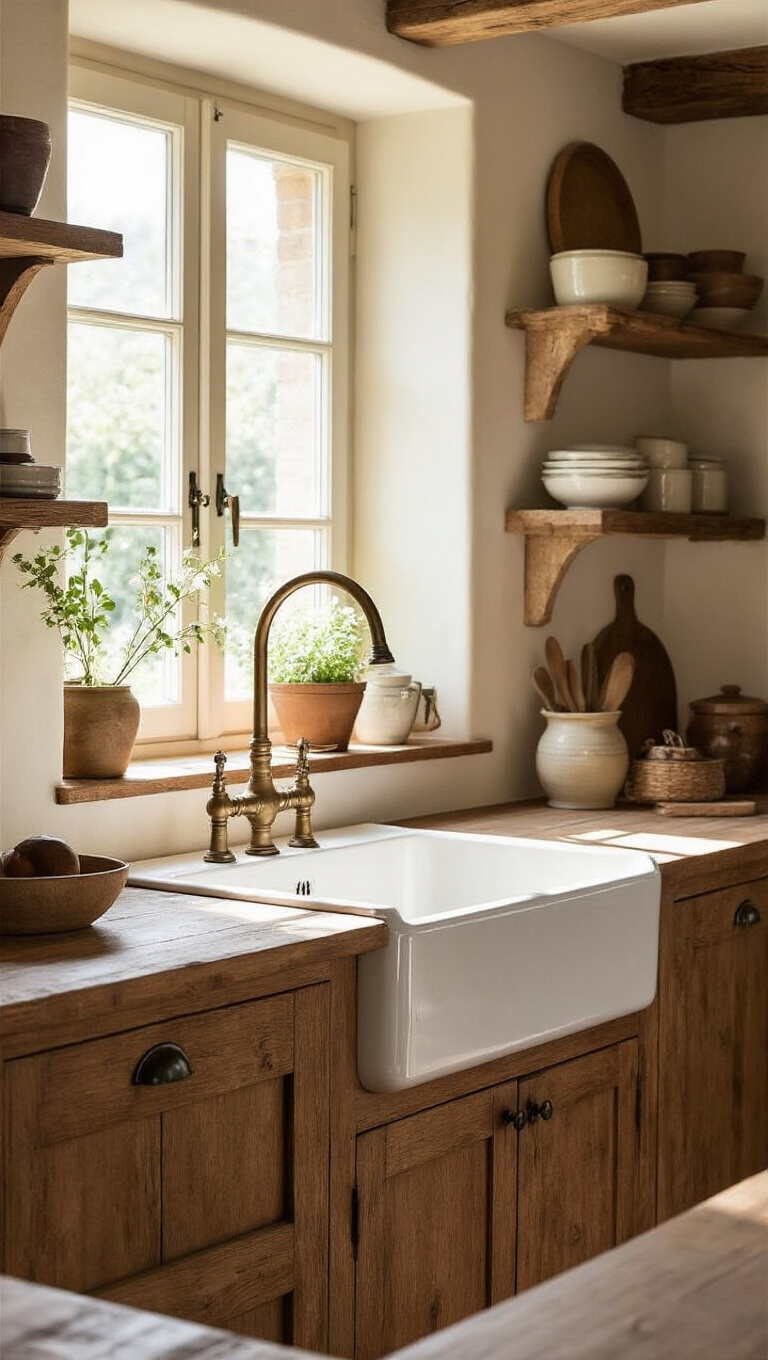
One of the secrets to capturing an authentic European farmhouse kitchen vibe lies in the details, especially when it comes to selecting artisanal fixtures. Opt for hand-forged iron handles, brass faucets with vintage patinas, or enamel sinks crafted in small European workshops. These elements not only provide functionality but also serve as focal points, adding layers of craftsmanship and authenticity to your kitchen. Each piece tells a story of traditional European manufacturing techniques, enhancing the overall aesthetic and creating a truly refined space.
Beyond just being beautiful, these artisanal pieces contribute to a cohesive and timeless design. Many European craftsmen use age-old techniques passed down through generations, ensuring that each fixture is not only unique but also built to last. This connection to history and quality enhances the longevity of your kitchen design. Incorporating these thoughtful touches allows the space to feel personalized and inviting, full of character and warmth, and ensures your European farmhouse kitchen remains in style through the years.
10. Elevating with Classic Farmhouse Lighting
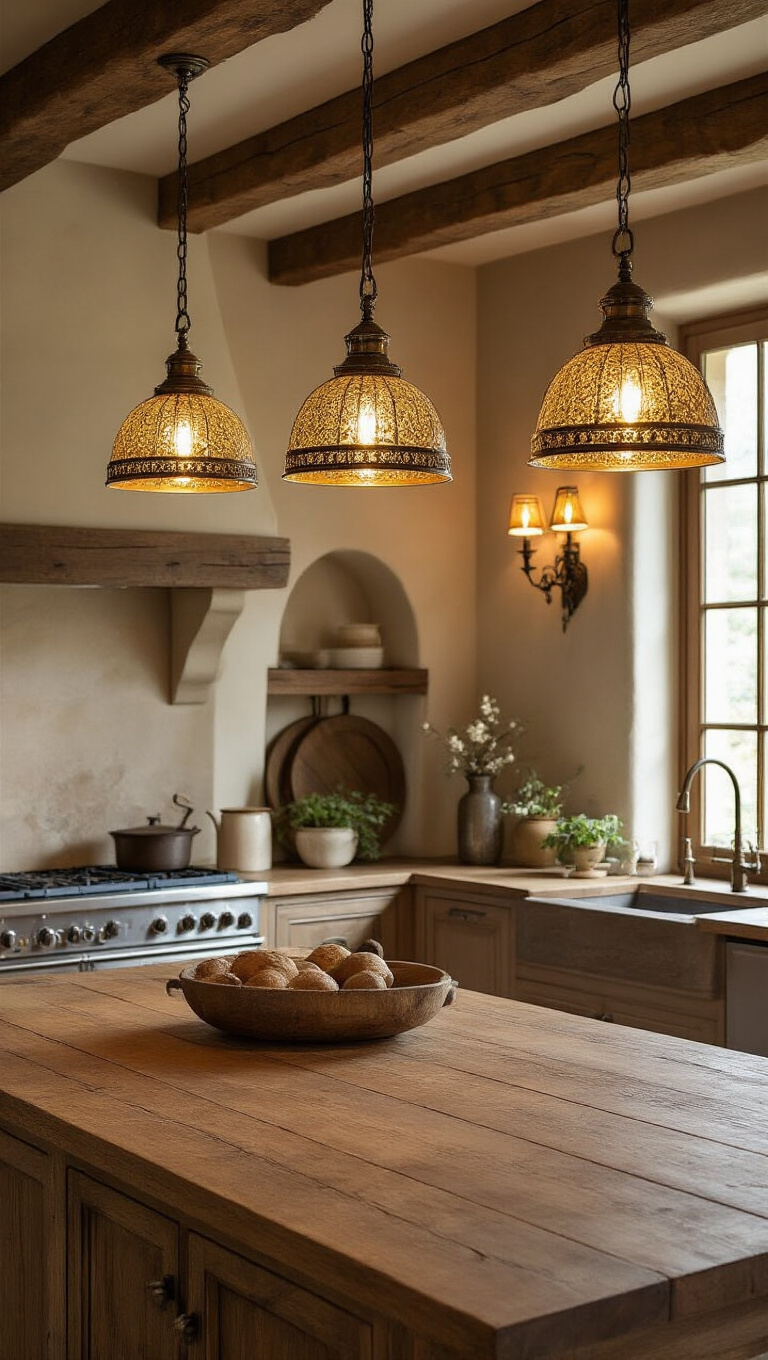
Lighting is a crucial component in achieving that quintessential European farmhouse kitchen charm. Opt for hanging pendant lights made from antique brass or wrought iron to introduce a touch of old-world elegance. Their timeless design serves as a perfect counterpoint to modern structures while enhancing the cozy, romantic atmosphere inherent in farmhouse style. Look for fixtures that mimic time-honored designs, such as those featuring curvilinear scrollwork or intricate filigree patterns, to tie together your kitchen’s rustic and refined elements seamlessly.
Consider incorporating task lighting under wooden cabinets or utilizing vintage-inspired sconces to create a warm, inviting glow. These fixtures not only boost the room’s functionality but also contribute a layer of visual interest that complements traditional European aesthetics. Remember, the goal is to balance form and function, so when selecting your lights, seek options that merge practical illumination with stylistic grace. The right lighting will highlight the natural materials and handcrafted details you’ve so thoughtfully incorporated into your space.
11. Enhancing Elegance with Stone Countertops
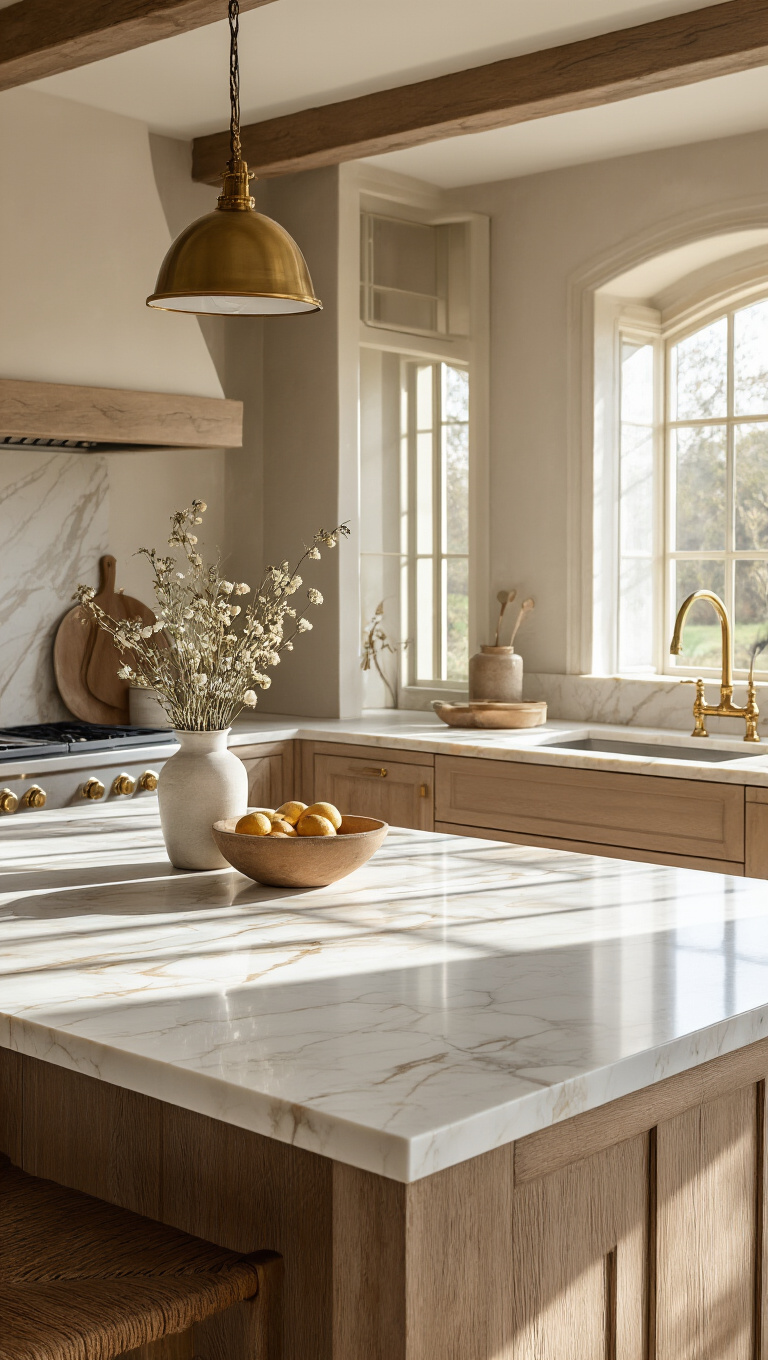
Stone countertops are a timeless addition to any kitchen, but in a European farmhouse design, they elevate the elegance and authenticity of the space. Opting for natural stones like marble or soapstone offers not only a durable and functional surface but also brings a touch of classic sophistication. These materials, with their unique veining and hues, can transform a kitchen into a charming and refined space, embodying the essence of European farmhouse kitchens.
Beyond their visual appeal, stone countertops are incredibly practical, making them highly desirable for busy kitchens. Marble, for example, is renowned for its heat resistance, which is perfect for avid bakers and chefs. Meanwhile, soapstone, with its natural non-porous surface, is easy to clean and maintain, ensuring hygiene without compromising on style. By incorporating these elements, your kitchen can seamlessly blend traditional warmth with contemporary functionality, characteristic of an authentic European farmhouse kitchen.
12. Captivating with Elegant Farmhouse Table Settings
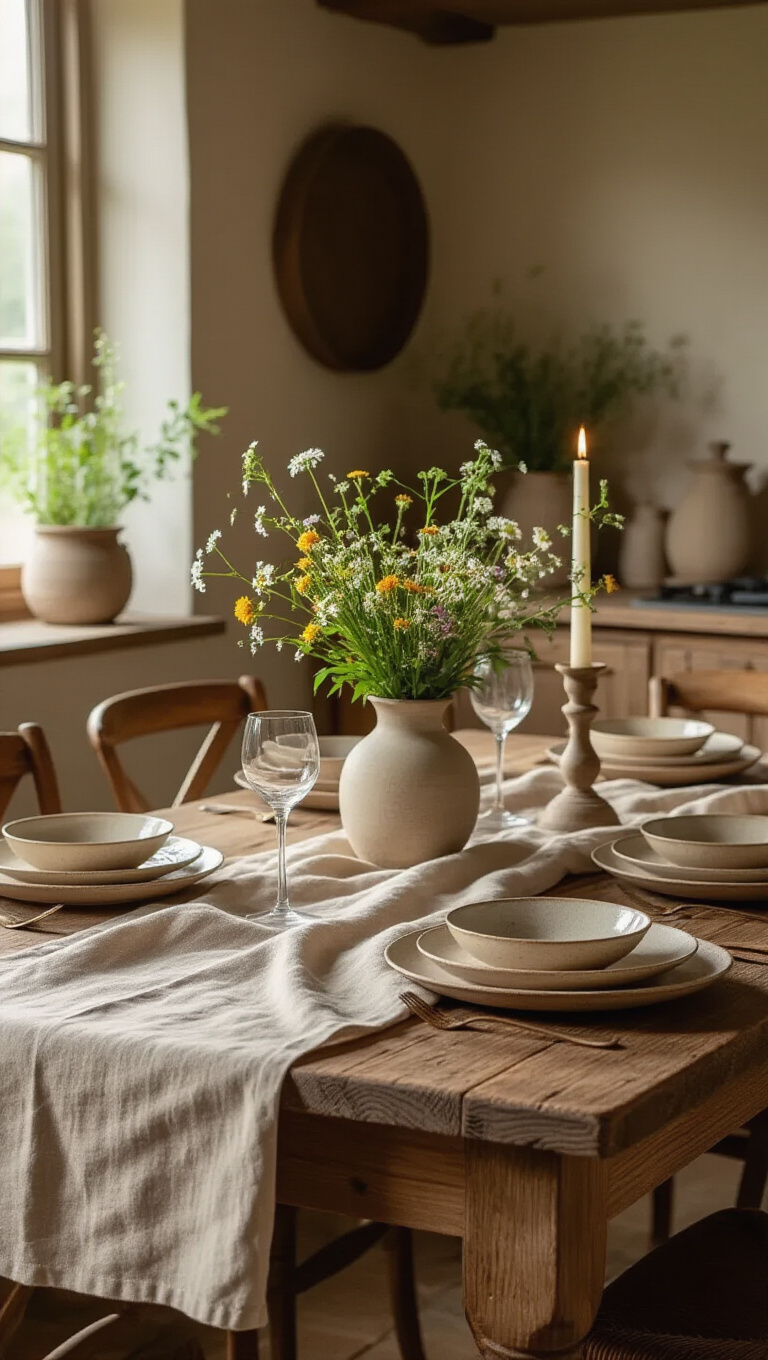
A European farmhouse kitchen isn’t just about the structures and finishes; it’s also about how you present meals. Creating an inviting table setting can elevate the kitchen’s ambiance and make every meal feel like an occasion. Start with a sturdy wooden farmhouse table as the centerpiece, reflecting the rustic charm of European countryside homes. Dress it with linen tablecloths in soft, neutral tones or gentle, earthy colors. Add layers with classic European stoneware or fine china for a refined touch. This mix of textures and materials not only enhances the visual appeal but also creates an inviting setting that encourages long, leisurely meals.
To complete the warm, communal feeling typical of a European farmhouse kitchen, incorporate thoughtful details like handmade napkin rings or simple floral arrangements from near fields or garden. Use candles in vintage holders to add a warm, cozy glow that perfectly captures the essence of a rural European evening. This approach not only celebrates the tradition of slow dining but also showcases your attention to detail, making your kitchen equally functional and beautiful. The careful assembly of these elements can transform your kitchen into a welcoming space that pays homage to the elegance and simplicity of European living.
13. Bringing Inherit Charm with Classic European Tableware
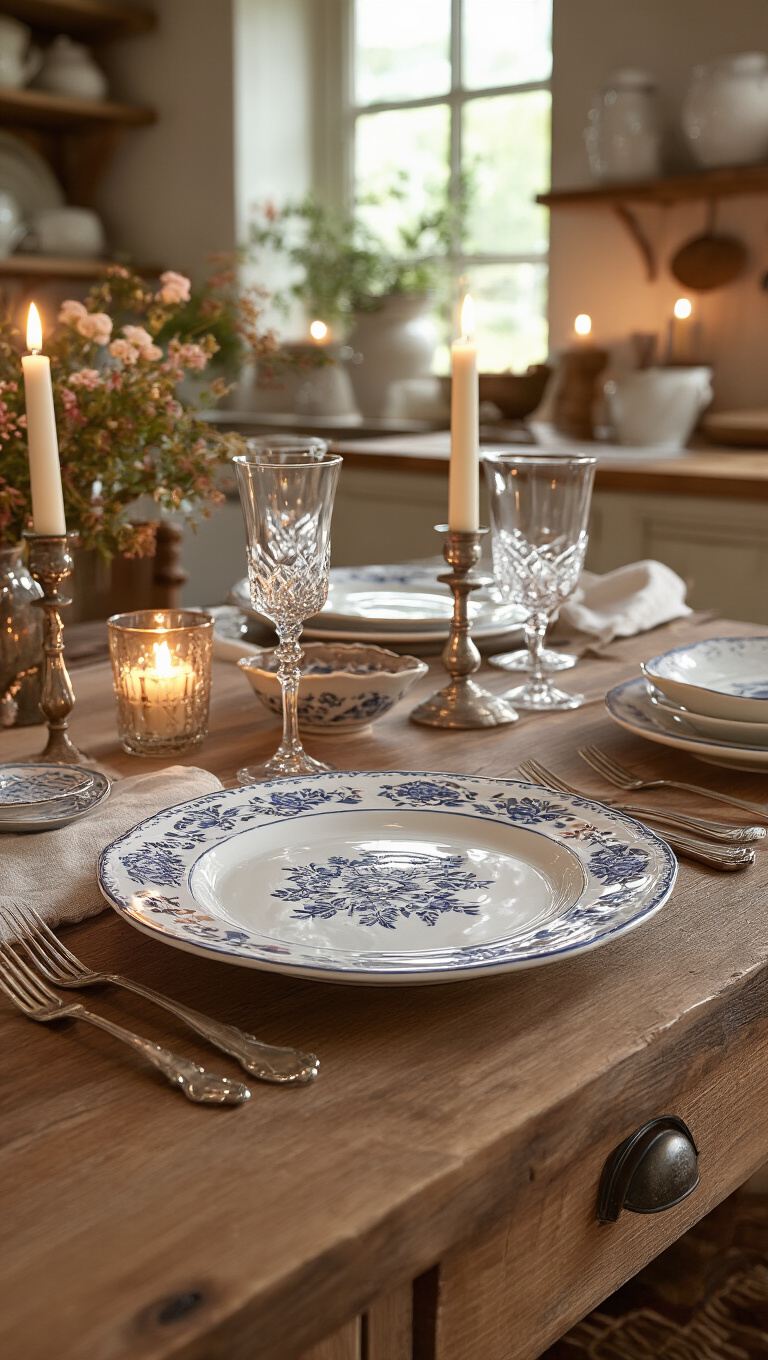
The essence of a European farmhouse kitchen often shines through in the finer details, and what better way to capture this than through the choice of tableware? Classic European tableware like hand-painted ceramic plates, vintage cutlery, and intricately detailed glassware can transform a simple meal into an elegant dining experience. By integrating these charming pieces, you not only embrace the storied history of European design but also add a refined touch that speaks to timeless elegance.
When selecting tableware for your European farmhouse kitchen, consider pieces that tell a story. Whether it’s the artisanal craftsmanship of Portuguese azulejos-inspired plates or French Provencal motifs, these elements infuse character and depth into the everyday ritual of dining. The integration of such charming tableware complements the rustic elegance of your kitchen, creating a cohesive and captivating aesthetic that invites warmth and hospitality.
14. Displaying Verdant Herb Gardens
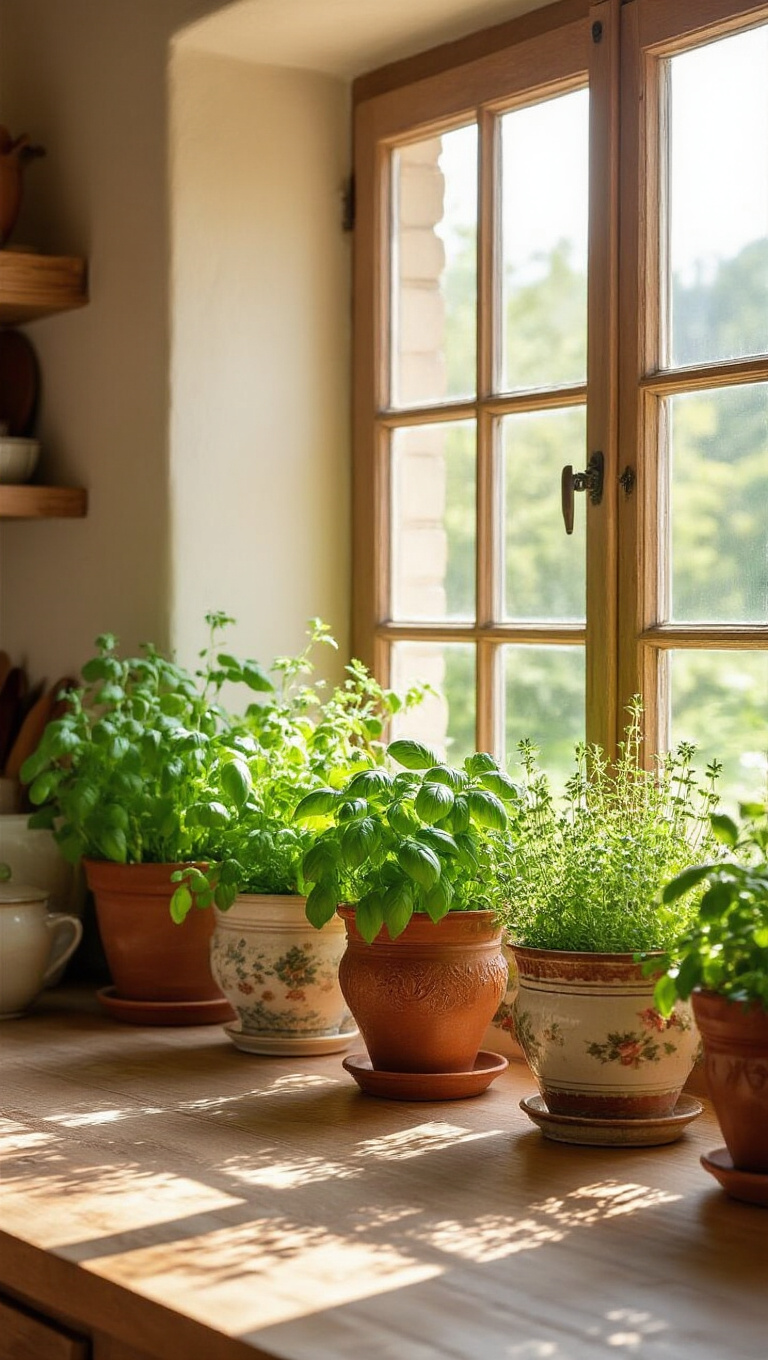
Bringing the outdoors in is a timeless way to enhance the charm of a European farmhouse kitchen. By creating verdant herb gardens within your kitchen space, you can infuse the area with both beauty and utility. Arrange potted herbs like basil, thyme, and rosemary along a sun-drenched windowsill or in hanging planters to add vibrant pops of green. Not only do they invigorate the room with their fresh aroma, but they also provide an easily accessible supply of fresh ingredients for your culinary adventures.
Integrating live plants into your decor introduces a natural element that complements the rustic elegance of European farmhouse kitchens. Choose antique pots or ornate terracotta planters to maintain the vintage aesthetic, and ensure you place them where they receive ample sunlight. In addition to their aesthetic benefits, these herbs can become a conversation starter, offering a touch of earthiness and authenticity that embodies the heart and soul of true European farmhouse design.
15. Infusing Personality with Antique European Furniture
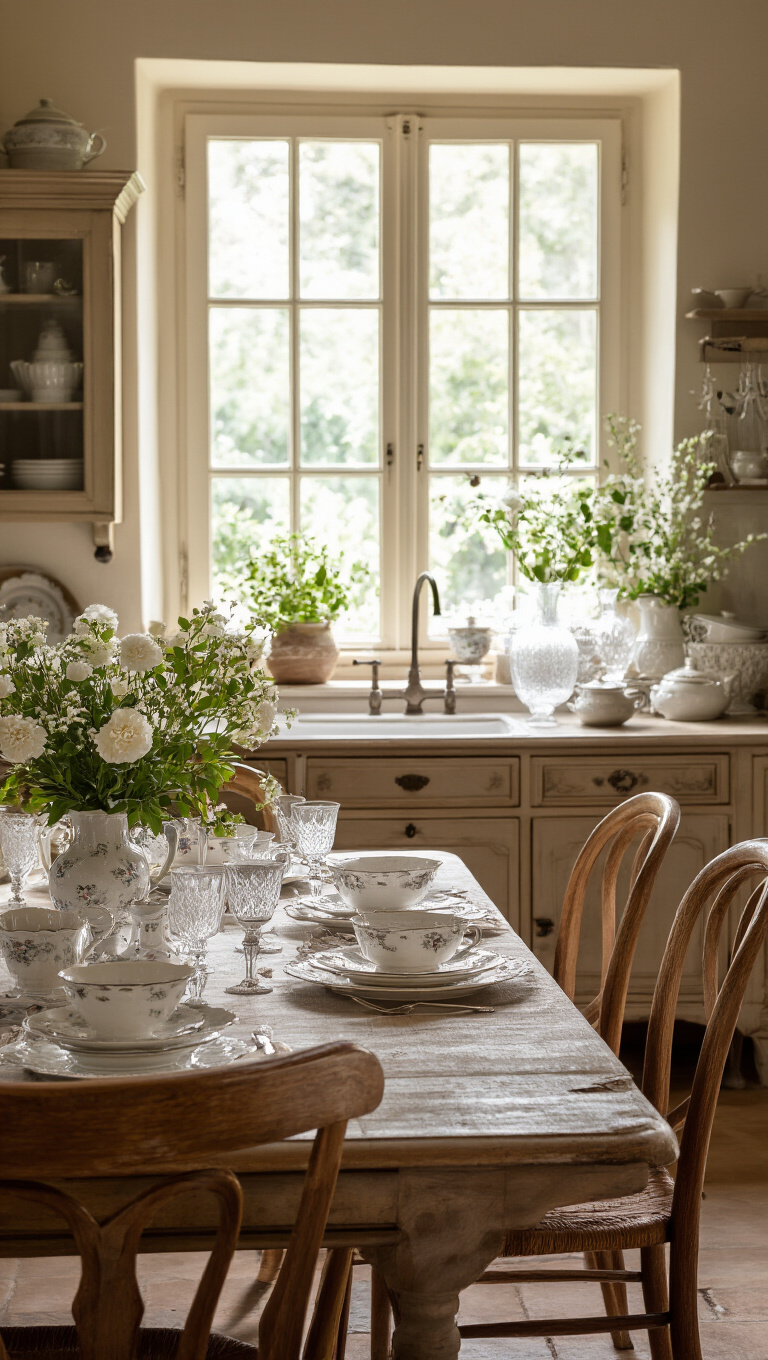
To complete the refined look of your European farmhouse kitchen, consider incorporating antique European furniture. These pieces add a historical charm and a sense of lived-in elegance that newer items simply can’t replicate. Imagine a beautifully aged French farmhouse table or a rustic English dresser, each telling its own story and drawing the eye with its distinctive craftsmanship. The weathered wood and time-worn patina of these furnishings create a warm, inviting atmosphere, bridging the gap between the past and present in your kitchen space.
When selecting antique European furniture, focus on pieces that complement your kitchen’s existing themes and color palettes. Look for items with intricate detailing, like hand-carved legs or inlaid panels, which can become conversation starters in your home. Pairing these antiques with more modern elements can create a striking contrast that enhances the overall aesthetic. Remember, the goal is to express your personality through select, meaningful pieces that resonate with your style, adding a layer of character and sophistication to your European farmhouse kitchen.
Conclusion
In summary, designing a European farmhouse kitchen involves balancing rustic charm with elegant details to create a space that is both functional and aesthetically pleasing. By incorporating elements such as natural materials, vintage accents, and a neutral color palette, you can transform your kitchen into a refined oasis that embodies the timeless beauty of European country living.

